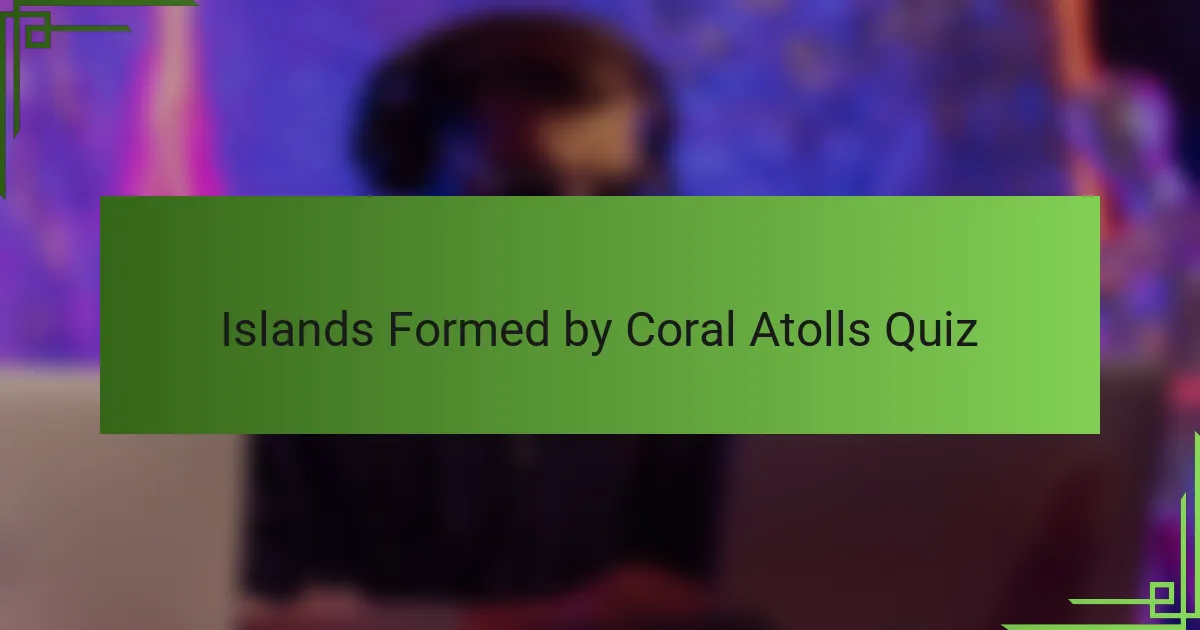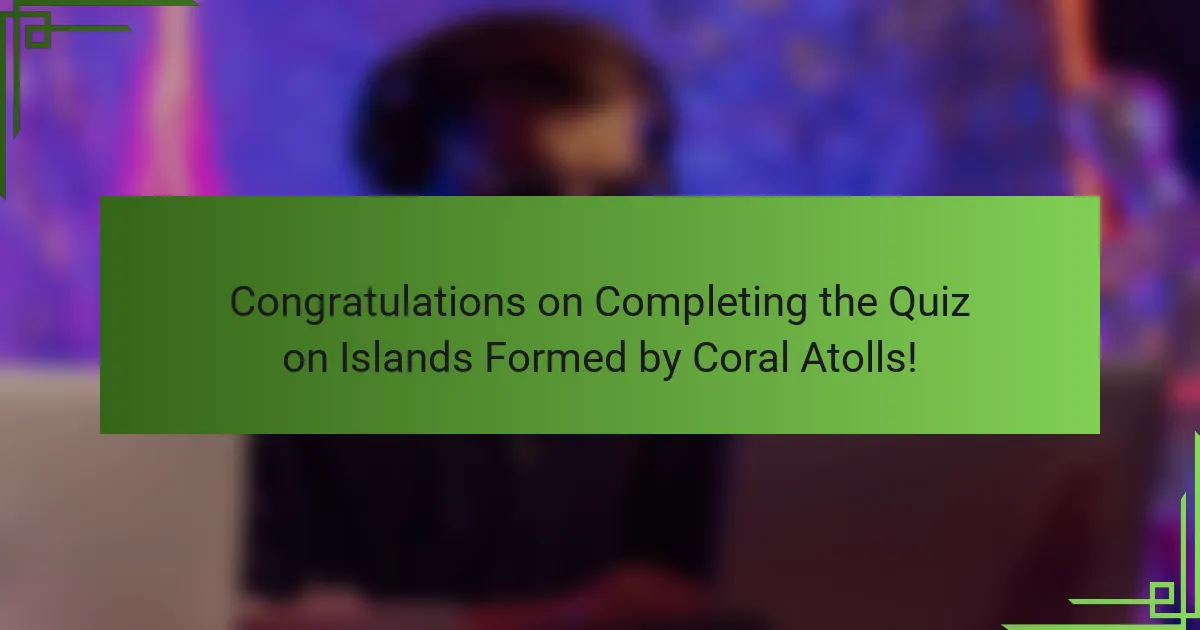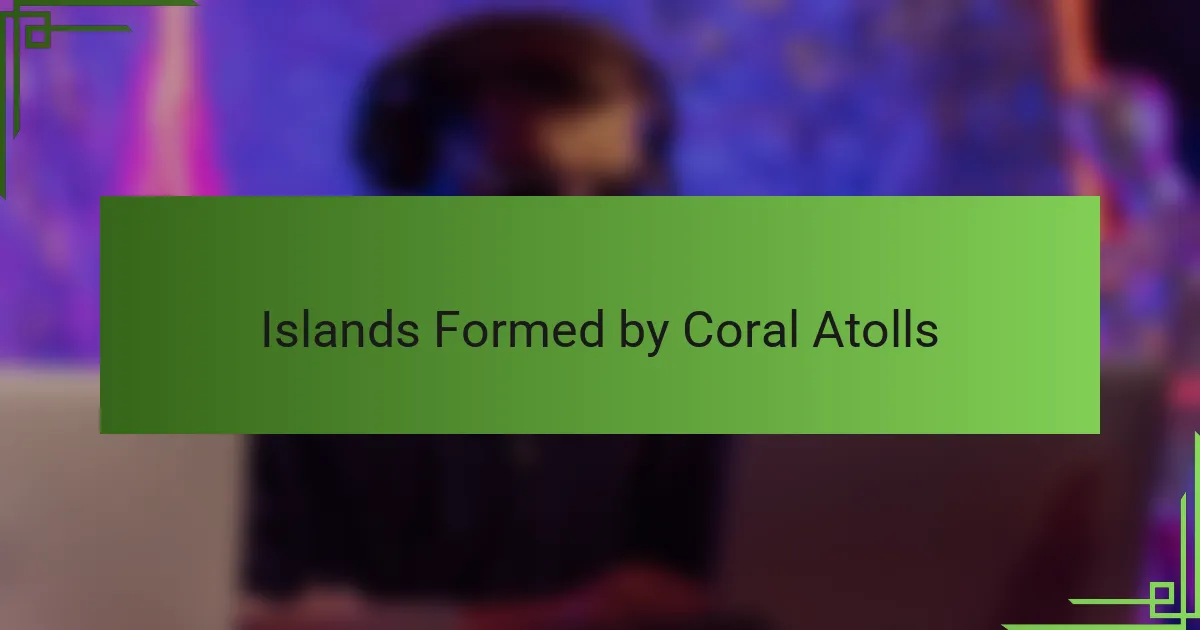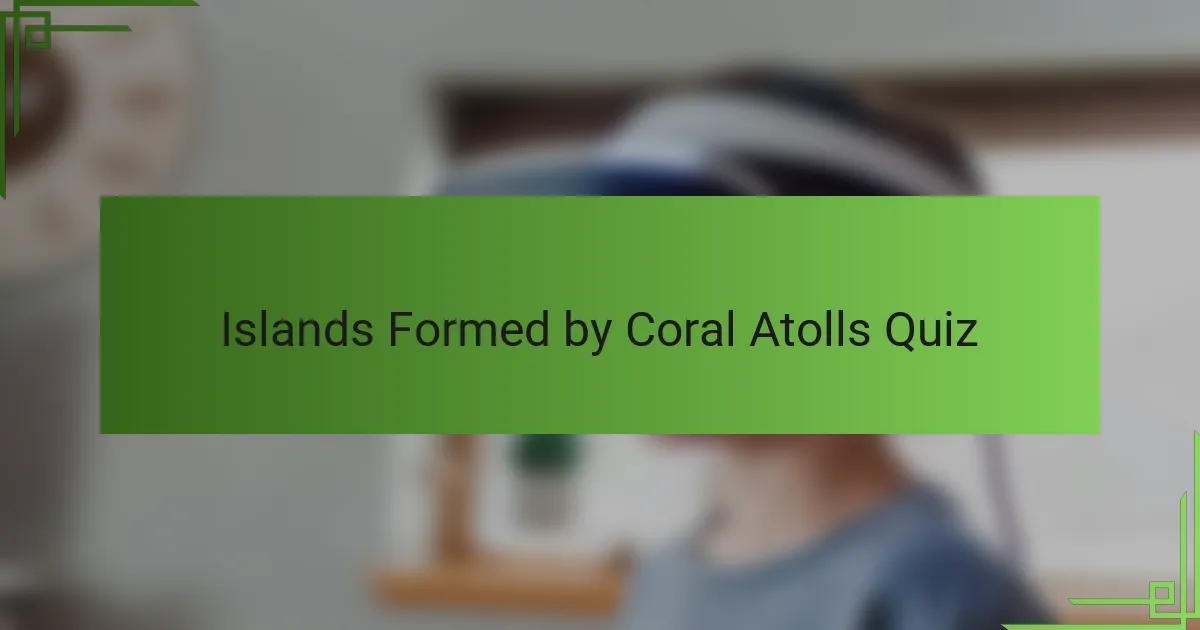
Islands Formed by Coral Atolls Quiz
1. What coral atoll in the Pacific Ocean is known as the world`s largest atoll by land area?
- Enewetak Atoll
- Tarawa Atoll
- Bikini Atoll
- Kwajalein Atoll
2. Which country administers the coral atoll of Aldabra, recognized as a UNESCO World Heritage site?
- Comoros
- Maldives
- Mauritius
- Seychelles
3. The Maldives is famous for being composed of numerous coral atolls in which ocean?
- Atlantic Ocean
- Southern Ocean
- Pacific Ocean
- Indian Ocean
4. What is the name of the atoll that forms part of the Republic of the Marshall Islands and was the site of U.S. nuclear testing during the Cold War?
- Kwajalein Atoll
- Enewetak Atoll
- Rongelap Atoll
- Bikini Atoll
5. Which coral atoll in the Indian Ocean is an overseas territory of France?
- French Southern and Antarctic Lands
- Seychelles
- Maldives
- Comoros
6. What atoll, part of Kiribati, is notable for being near the geographic center of the Earth’s surface?
- Kiritimati Atoll
- Tabuaeran Atoll
- Tarawa Atoll
- Banaba Atoll
7. What coral atoll in the Caribbean Sea is part of Belize and known for its large barrier reef?
- Ambergris Caye
- Glover’s Reef
- Turneffe Atoll
- Lighthouse Reef
8. Which Pacific coral atoll is famous for being a major filming location for the “Survivor” reality TV series?
- Fiji`s Yasawa Islands
- Tonga`s Vava`u Group
- Cook Islands` Aitutaki
- Palau`s Koror Island
9. What is the name of the coral atoll that makes up the majority of the population and landmass of Tuvalu?
- Nanumea
- Nukufetau
- Funafuti
- Vaitupu
10. Which atoll in the South Pacific Ocean is the easternmost part of the Federated States of Micronesia?
- Chuuk Atoll
- Pohnpei Atoll
- Kosrae Atoll
- Pingelap Atoll
11. What coral atoll serves as the capital of the Maldives?
- Hinnavaru
- Thulhaagiri
- Malé
- Villingili
12. Which Australian coral atoll is the largest coral reef system in the world?
- Ningaloo Reef
- Coral Sea Atoll
- Lord Howe Reef
- Great Barrier Reef
13. What is the name of the coral atoll that is an overseas territory known for the research station on its island, located in the Indian Ocean?
- Juan de Nova Island
- Tromelin Island
- Glorioso Islands
- Europa Island
14. Which coral atoll in French Polynesia is a UNESCO Biosphere Reserve known for its turquoise lagoon?
- Tikehau
- Rangiroa
- Manihi
- Fakarava
15. What coral atoll in the northern Indian Ocean is the site of the capital city of the Maldives?
- Addu Atoll
- Malé Atoll
- Haa Alif Atoll
- Faafu Atoll

Congratulations on Completing the Quiz on Islands Formed by Coral Atolls!
You’ve just explored fascinating aspects of geography by learning about islands formed by coral atolls. This quiz helped you understand how these unique landforms develop from coral reefs, the role of marine life in their creation, and their ecological importance. It’s rewarding to see how natural processes shape some of the most beautiful islands on Earth.
Throughout the quiz, you likely discovered interesting facts about coral growth, how atolls surround lagoons, and their significance for coastal ecosystems. Such knowledge enhances your appreciation for marine biodiversity and the delicate balance that sustains these environments. It also highlights the impact of environmental changes on these fragile island systems.
Ready to deepen your understanding? Check out the next section on this page, where we provide detailed information on the formation, structure, and environmental role of coral atolls. This will expand what you’ve learned and offer new insights into the geography of these remarkable islands. Keep exploring and enjoy the journey!

Islands Formed by Coral Atolls
Definition and Formation of Coral Atoll Islands
Coral atoll islands are ring-shaped landforms created by the growth of coral reefs surrounding a subsiding volcanic island. Initially, a volcanic island forms and is colonized by coral organisms, primarily hermatypic corals. Over time, the volcanic island erodes and sinks slowly, while coral reefs continue to grow upward and outward. This process results in a coral reef encircling a lagoon, forming an atoll. Charles Darwin first explained this formation process in the 19th century during his study of the Pacific Ocean’s coral reefs.
Geographical Distribution of Coral Atoll Islands
Coral atoll islands are predominantly found in tropical and subtropical ocean waters, where warm sea temperatures enable coral growth. Notable regions include the Pacific Ocean, especially the islands of the Maldives in the Indian Ocean and the Marshall Islands and Kiribati in the Pacific Ocean. These geographic locations provide the ideal conditions for coral proliferation and atoll formation due to their stable, warm climates and clear, shallow waters.
Ecological Characteristics of Coral Atoll Islands
Coral atoll islands exhibit unique ecological systems centered around coral reefs, lagoons, and sandy islets. The coral reefs support rich biodiversity, including various species of corals, fish, mollusks, and crustaceans. Vegetation is generally sparse but includes salt-tolerant plants and coconut palms. The shallow lagoons inside atolls provide habitats for seagrasses and juvenile fish. The Great Barrier Reef near Australia and the Bikini Atoll in the Marshall Islands are examples where coral ecology plays a critical role in island environments.
Human Settlements and Challenges on Coral Atoll Islands
Many coral atoll islands support small human populations, such as in Tuvalu and the Maldives. These communities depend on fishing, coconut harvesting, and limited agriculture. However, atoll islands face significant challenges including freshwater scarcity, limited land area, and vulnerability to sea-level rise caused by climate change. The low elevation and porous coral rock make these islands susceptible to flooding, increasingly threatening the livelihoods and existence of their inhabitants.
Role of Coral Atoll Islands in Global Geography and Climate Studies
Coral atoll islands are vital indicators in environmental studies, particularly in monitoring climate impacts such as sea-level rise and ocean acidification. Geographic research uses atolls as natural laboratories to study coral reef health and island resilience. Institutions like the International Coral Reef Initiative and the United Nations Environment Programme conduct ongoing research to understand changes in atoll geography and to guide conservation and adaptation strategies globally.
What are islands formed by coral atolls?
Islands formed by coral atolls are ring-shaped landforms consisting of coral reefs that encircle a lagoon. They develop from coral growth on the rim of submerged volcanic islands. Over time, the volcanic island erodes and sinks, while the coral continues to grow upward, creating a ring-shaped island. The Maldives in the Indian Ocean is a prime example of islands formed by coral atolls.
How do coral atoll islands form?
Coral atoll islands form through a process starting with a volcanic island surrounded by coral reefs. As the volcanic island erodes and sinks slowly, coral growth persists upward toward the sunlight, maintaining the reef structure. Eventually, the volcanic island is submerged below sea level, leaving a coral ring with a central lagoon. This theory was first proposed by Charles Darwin during his voyage on the HMS Beagle.
Where are coral atoll islands commonly found?
Coral atoll islands are commonly found in tropical ocean regions, particularly in the Pacific and Indian Oceans. Notable locations include the Maldives in the Indian Ocean, the Marshall Islands, and the Tuamotu Archipelago in the Pacific Ocean. These areas provide warm waters and clear, shallow seas, which are essential for coral growth.
When do coral atolls typically develop?
Coral atolls develop over thousands to millions of years. The process begins with volcanic island formation, followed by gradual subsidence and continuous coral reef growth. The time frame depends on the rate of volcanic island sinking and coral growth rates, which is generally around 1 to 10 millimeters per year. This slow progression results in the formation of an atoll over geological timescales.
Who first explained the formation of coral atoll islands?
Charles Darwin first explained the formation of coral atoll islands. During his voyage on the HMS Beagle in the 1830s, he observed coral reefs surrounding submerged volcanic islands and formulated the atoll formation theory. His work was published in 1842 in “The Structure and Distribution of Coral Reefs,” which remains a foundational study in coral reef and island geology.
